Plants & Wild Flowers
Trees, shrubs and wild flowers you
may see on your trail ride.
You will pass an abundance of trees, shrubs and wild flowers as the trail
winds through the different ecosystems of the forest.
Organic matter, soil moisture, and slope determine the mix of plants. The hydric hammock is wet; the xeric hammock is dry; the mesic hammock is
in-between.
Plants and wild flowers that are native to Florida attract various native species of animals,
including butterflies and their larvae (caterpillars).
|
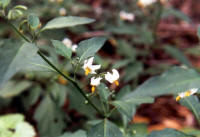 |
Common Nightshade
Solanum americanum
A small shrubby or low plant - small white flowers are
reminiscent of those seen on potato and tomato plants, since
they are closely related. Solanaceae (nightshade) family.
|
 |
Coralbean
Erythrina herbacea
One of the first showy, blooms in the early spring. Bright red
spike of flowers usually precedes the leaves. Stems are thorny.
The name coralbean refers to the beautifully colored seeds which
become apparent when the seed pods split open. Fabaceae (pea or
bean) family
|
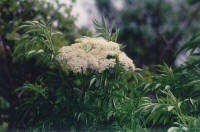 |
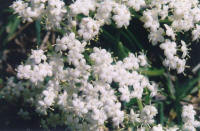 Florida Elder - Southern Elderberry
Florida Elder - Southern Elderberry
Sambucus canadensis/simpsonii
Large woody shrubs. Prominent display of small white
rounded heads, up to 10 inches in diameter. Blooms throughout
the Spring and early summer. Found outside and along the sides
of the Forest trail entrance. Black fruits (elderberries) in the
Fall are excellent for making jellies, pies, and wine. Caprifoliaceae (honeysuckle)
|
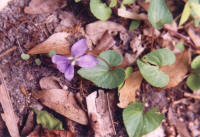 |
Florida Violet
Viola floridana
Found throughout the state in both wooded and open areas. The
heart shaped leaves serve to differentiate this from other
native violets in Florida.
Violaceae (Violet) family.
|
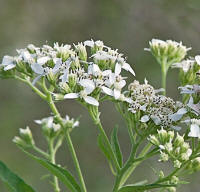 |
Frostweed
Verbesina virginica
Following the blooming period in the late summer and fall, these
attractive seed heads remain on the expired plants throughout
the following season. The large green leaves of the current
year's plants can always be found nearby. Asteraceae (aster)
family.
|
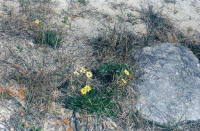 |
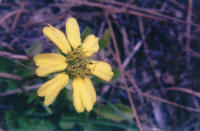 Greeneyes
Greeneyes
Berlandiera subacaulis
Preponderant flowering plant in the high dryer areas. Found throughout most of the year. Asteraceae (aster) family.
|
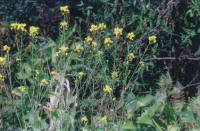
|
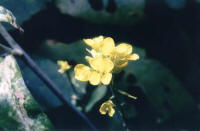 Indian Mustard or Leaf Mustard
Indian Mustard or Leaf Mustard
Brassica juncea
Tall annual with brightly colored flowers that have a typical
mustard configuration. After blooming in January, the flowers
are followed by elongated fusiform seed pods (siliques), which
remain as multiple rocket-like stalked extensions on the upper
part of the lifeless dried plants. Striking appearance while in
bloom. Brassicaceae
(mustard) family.
|
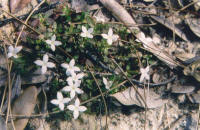 |
Innocence
Hedyotis procumbens
Low creeping plants. The Small flowers have four white petals,
with yellow colored central areas. Rubiaceae (madder) family.
|
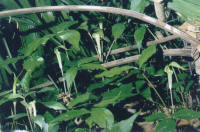 |
 Jack-in the Pulpit
Jack-in the Pulpit
Arisaema tryphyllum
Found in early spring in the hydric (low wet) area. Without the
flowers, the set of three shiny leaves resembles poison ivy.
Like many closely related plants, its tissues contain sharp
crystals of calcium oxalate (raphides), which, if ingested,
produce a prolonged sensation of stinging and swelling of the
mouth tissues. Araceae (arum) family
|
 |
Lyre-leaf Sage
Salvia lyrata
Common beautiful weedy annual. Blooms profusely along the
entrance road and around the Welcome Desk, in January, and
February. Its name is derived from the fact that the leaves
comprising the basal rosette are that is, divided transversely
into several lobes, the smallest at the base. Lamiaceae (mint)
family.
|
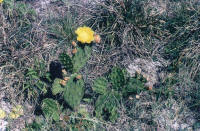 |
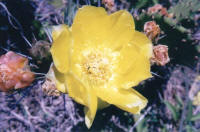 Prickly Pear Cactus
Prickly Pear Cactus
Opuntia bumifusa
Spiny, oval flattened stems are tightly joined together at
narrowed connection sites. The showy, flower is followed by an
edible pulpy, reddish many seeded fruit. Found scattered
throughout the Forest. Cactaceae (cactus) family.
|
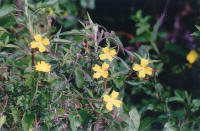 |
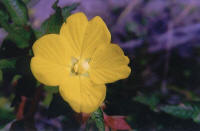 Primrose Willow
Primrose Willow
Ludwigia peruviana
Herbaceous to woody perennials. Found in and around swampy
ditches where it often forms large thickets. Outside Forest
entrance. Onagranaceae (evening primrose) family
|
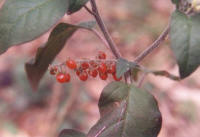 |
Rouge Plant
Rivina bumilis
The name of the plant refers to the moderately indelible
orange-red juice in the berries, which are preceded by
inconspicuous white Flowers. Seen in disturbed areas along the
trails. Phytolaccaceae (pokeweed) family
|
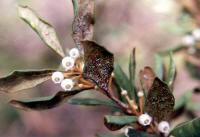 |
Rusty Lyonia
Lyonia ferruginea
Very, fragrant bell shaped flowers in April and May. Note the
strong characteristic downturning of the leaf margins and the
rusty, appearance of the stems. Ericaceae (heath) family.
|
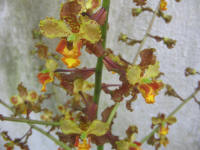 |
Wild Orchid
Cyrtopodium punctatum
Orchids have been around since the prehistoric ages. At the dawn
of the dinosaurs, orchids were blooming the exotic shapes of
this mysterious flower, that we can still admire in the Florida
forests.
|
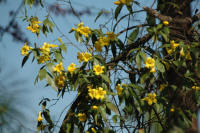 |
Yellow Jasmine
Jasminum floridum
This highly ornamental climbing or
trailing plant is abundant in parts of
the forest, its slender stems festooned
over trees making its presence known by
the delightful perfume from its flowers,
filling the air with fragrance that is
almost overpowering. The smooth, shining
stems of this vine sometimes reach a
length of 20 feet. The flowers,
which appear from January to April, are
bright yellow, about 1 inche long are
very fragrant but poisonous.
|
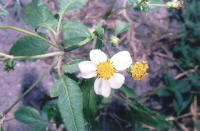 |
Spanish Needles
Bidens alba
Common weedy plant. It is usual not to have a
complete set of ray florets, giving the flowers an asymmetrical
or incomplete took. Bidens refers to the two pointed teeth on
the seeds, which cause them to stick to clothing as "booby
lice". Alba refers to the white floral petals. Found throughout
the year along the Forest trails, and in many disturbed areas. Asteraceae (aster or daisy) family.
|
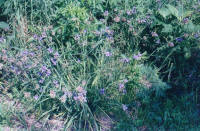 |
 Spiderwort Spiderwort
Tradescantia obiensis
Bright blue-violet colored flowers appear fresh and vigorous
each morning, only to become wilted and dried by the afternoon.
Found along the Forest trails throughout the wet periods of the
year. Commelinaceae (spiderwort or dayflower) family.
 |